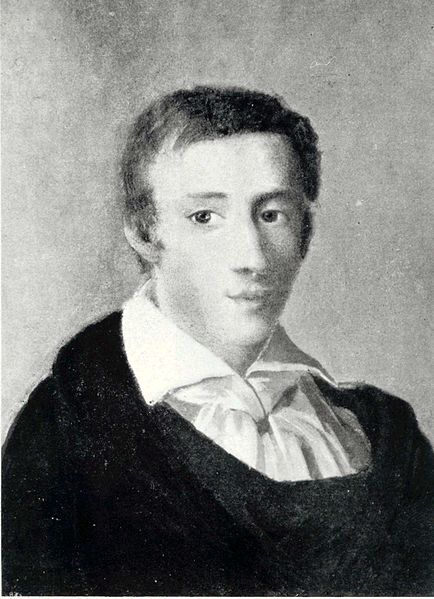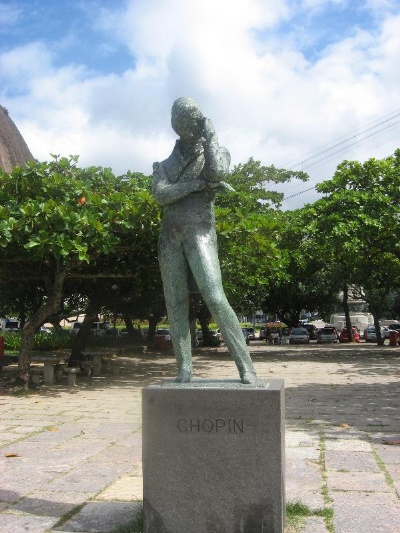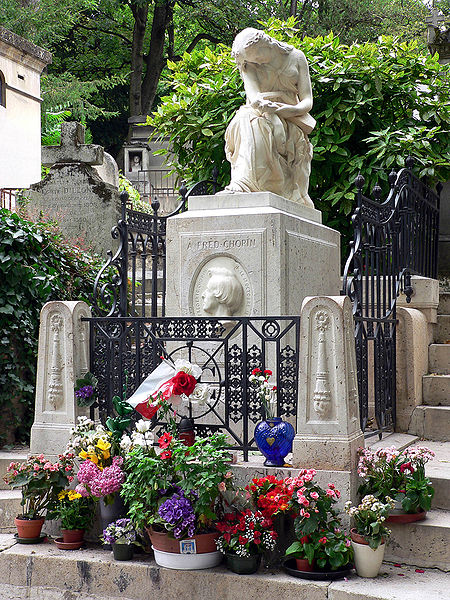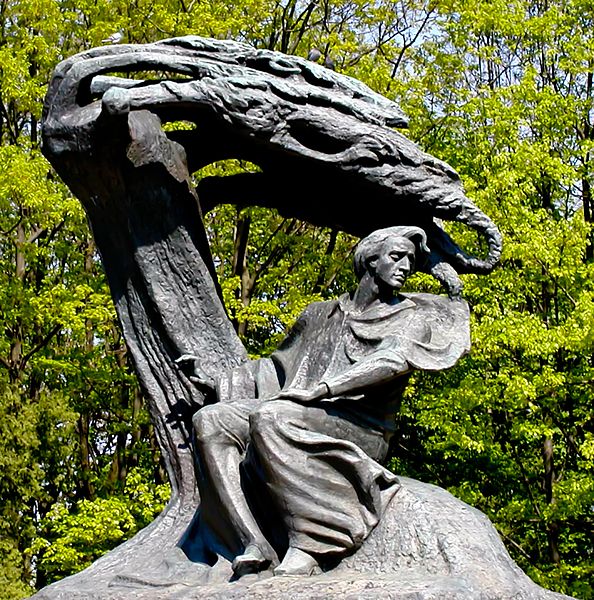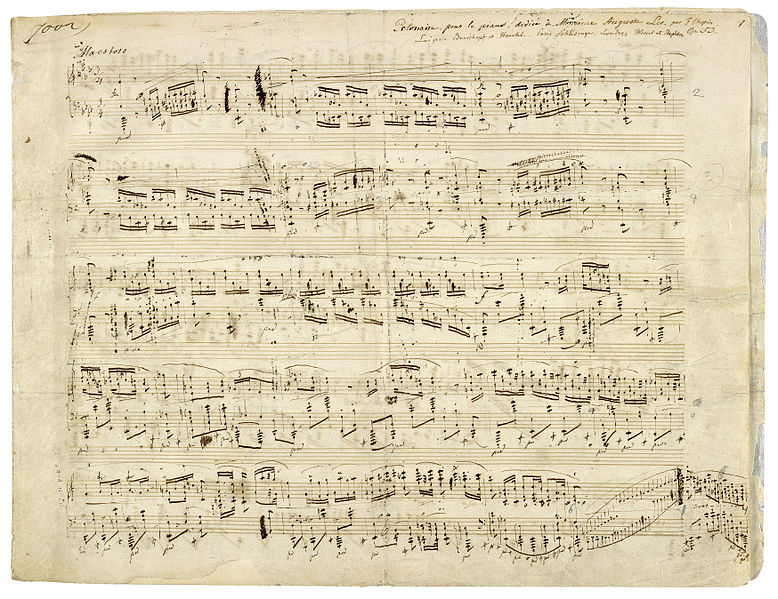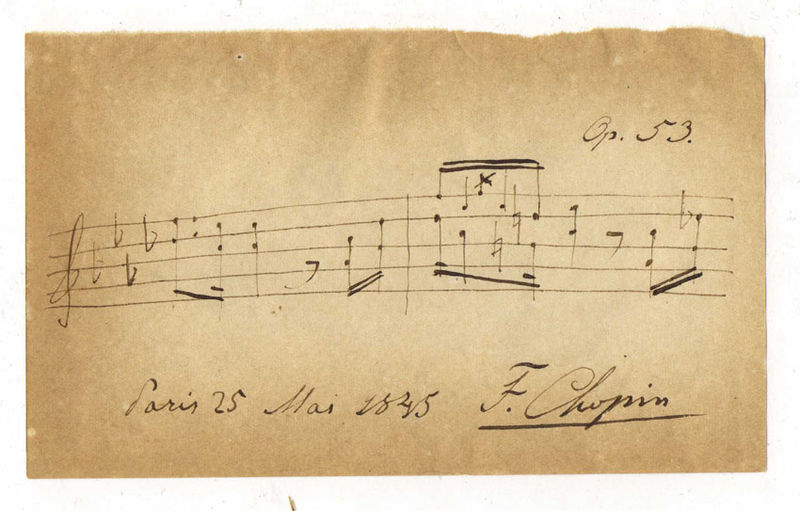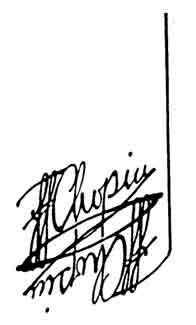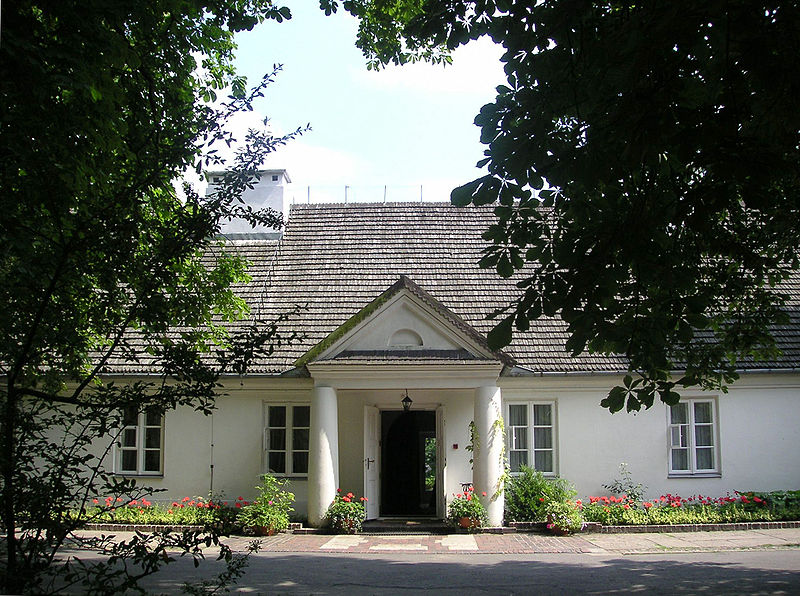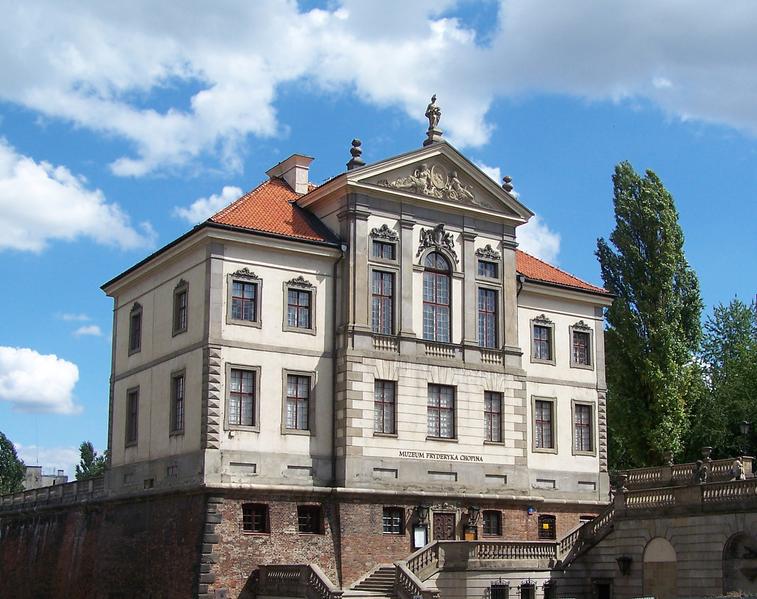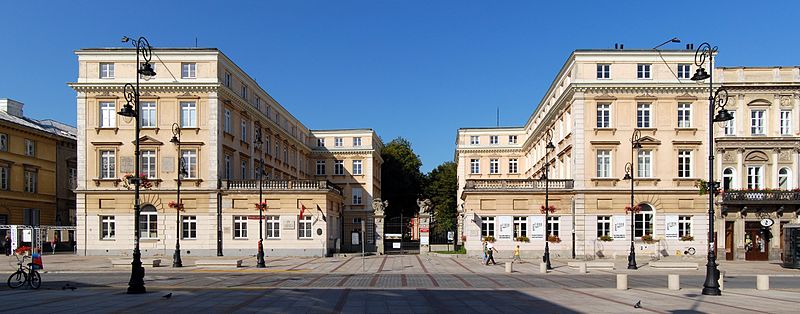<Back to Index>
- Composer Frédéric François Chopin, 1810
PAGE SPONSOR
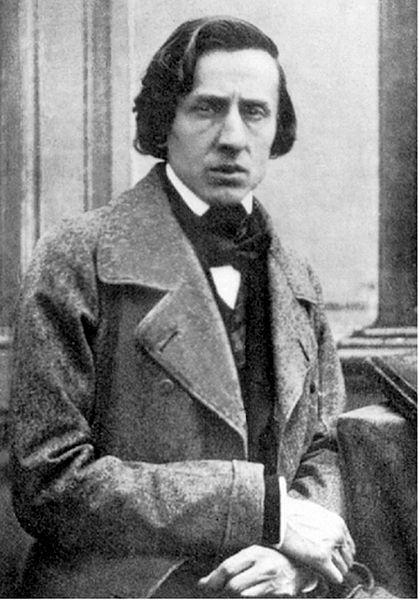
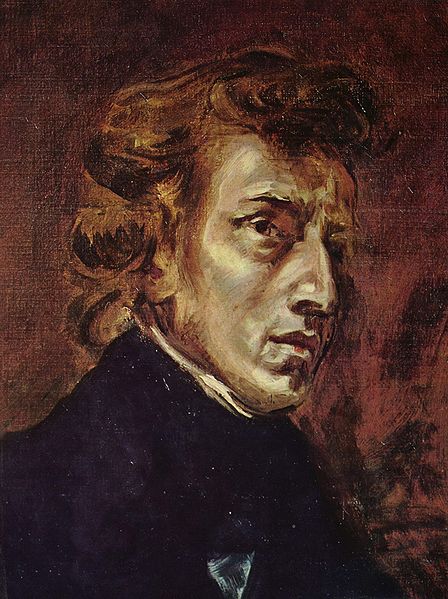
Frédéric François Chopin (Polish: Fryderyk Franciszek Chopin; 22 February or 1 March 1810 – 17 October 1849) was a Polish composer, virtuoso pianist, and music teacher of French – Polish parentage. He was one of the great masters of Romantic music and has been called "the poet of the piano".
Chopin was born in Żelazowa Wola, a village in the Duchy of Warsaw. A renowned child prodigy pianist and composer, he grew up in Warsaw and completed his musical education there. Following the Russian suppression of the Polish November 1830 Uprising, he settled in Paris as part of the Polish Great Emigration. He supported himself as a composer and piano teacher, giving few public performances. From 1837 to 1847 he carried on a relationship with the French woman writer George Sand. For most of his life, Chopin suffered from poor health; he died in Paris in 1849 at the age of 39.
The vast majority of Chopin's works are exclusively for solo piano, the most notable exceptions being his two piano concertos. His compositions are technically demanding but emphasize nuance and expressive depth. Chopin invented the musical form known as the instrumental ballade and made major innovations to the piano sonata, mazurka, waltz, nocturne, polonaise, étude, impromptu, scherzo, and prélude.
Chopin's father was Nicolas Chopin, a Frenchman from Lorraine who had emigrated to Poland in 1787 at the age of sixteen and had served in Poland's National Guard during the Kościuszko Uprising (1794). In France he had been baptized Nicolas but later, living in Poland, he used the Polish form of his given name, Mikołaj. He subsequently tutored children of the aristocracy, including the Skarbeks, whose poorer relative, Justyna Krzyżanowska, he married. The wedding took place at the 16th century parish church in Brochów on 2 June 1806. (Justyna's brother would become the father of American Union General Włodzimierz Krzyżanowski.)
Frédéric Chopin was the couple's second child and only son. (The eldest child, Ludwika, was to become his first piano teacher, and several decades later was to repatriate his heart from Paris.) He was born at Żelazowa Wola, forty - six kilometres west of Warsaw, in what was the Duchy of Warsaw. The parish baptismal record, discovered in 1892, gives his birthday as 22 February 1810, but a date one week later, 1 March, was stated by the composer and his family as his birthday; according to Chopin in a letter of 16 January 1833 to the chairman of the Polish Literary Society in Paris, he was "born 1 March 1810 at the village of Żelazowa Wola in the Province of Mazowsze." He was baptized on Easter Sunday, 23 April 1810, in the same Brochów church where his parents had married. The parish register cites his given names in the Latin form Fridericus Franciscus; in Polish, he was Fryderyk Franciszek. His godfather was Fryderyk Skarbek (1792 – 1866), a former pupil of Nicolas Chopin — a prison reformer who would design the Pawiak Prison of later ill fame, and great - great - uncle of World War II SOE agent Krystyna Skarbek; the godfather's son Józef Skarbek would, in 1841, marry Frédéric Chopin's erstwhile fiancée Maria Wodzińska.
In October 1810, when Chopin was seven months old, the family moved to Warsaw, where his father had accepted an offer from lexicographer Samuel Linde to teach French at the Warsaw Lyceum. The school was housed in the Saxon Palace, and the Chopin family lived on the palace grounds. In 1817 Grand Duke Constantine requisitioned the Saxon Palace for military purposes, and the Lyceum was moved to the Kazimierz Palace, which also hosted the newly founded Warsaw University. The family lived in a spacious second floor apartment in an adjacent building. Chopin attended the Warsaw Lyceum from 1823 to 1826.
The Polish spirit, culture and language pervaded the Chopins' home, and as a result the son would never, even in Paris, perfectly master the French language. Louis Énault, a biographer, borrowed George Sand's phrase to describe Chopin as being "more Polish than Poland".
Others in Chopin's family were musically talented. Chopin's father played the flute and violin; his mother played the piano and gave lessons to boys in the elite boarding house that the Chopins maintained. As a result Frederic became conversant with music in its various forms at an early age.
Józef Sikorski, a musician and Chopin's contemporary, recalls in his Memoirs about Chopin (Wspomnienie Chopina)
that, as a child, Chopin wept with emotion when his mother played the
piano. By six, he was already trying to reproduce what he heard or make
up new melodies. He received his earliest piano lessons not from his mother but from his older sister Ludwika (in English, "Louise").
Chopin's first professional piano tutor, from 1816 to 1822, was the Czech Wojciech Żywny. Though the youngster's skills soon surpassed his teacher's, Chopin later spoke highly of Żywny. Seven year old "little Chopin" (Szopenek) began giving public concerts that soon prompted comparisons with Mozart as a child and with Beethoven.
That same year, seven year old Chopin composed two Polonaises, in G minor and B-flat major. The first was published in the engraving workshop of Father Izydor Józef Cybulski (composer, engraver, director of an organists' school, and one of the few music publishers in Poland); the second survives as a manuscript prepared by Nicolas Chopin. These small works were said to rival not only the popular polonaises of leading Warsaw composers, but the famous Polonaises of Michał Kleofas Ogiński. A substantial development of melodic and harmonic invention and of piano technique was shown in Chopin's next known Polonaise, in A-flat major, which the young artist offered in 1821 as a name day gift to Żywny.
About this time, at the age of eleven, Chopin performed in the presence of Alexander I, Tsar of Russia, who was in Warsaw to open the Sejm (Polish Parliament).
As
a child, Chopin displayed an intelligence that was said to absorb
everything and make use of everything for its development. He early
showed remarkable abilities in observation and sketching, a keen wit and
sense of humor, and an uncommon talent for mimicry. A
story from his school years recounts a teacher being pleasantly
surprised by a superb portrait that Chopin had drawn of him in class.
In those years, Chopin was sometimes invited to the Belweder Palace as playmate to the son of Russian Poland's ruler, Grand Duke Constantine, and charmed the irascible duke with his piano playing. (A few years later, the Duke would flee the Belweder, just in the nick of time, at the very opening of the November 1830 Uprising, escaping the Polish officer cadets who rode up through the Royal Baths Park from their barracks in an effort to capture him.)
Julian Ursyn Niemcewicz attested to "little Chopin's" popularity in his dramatic eclogue, "Nasze Verkehry" ("Our Intercourse", 1818), in which the eight year old featured as a motif in the dialogues.
In the 1820s, when teenage Chopin was attending the Warsaw Lyceum and Warsaw Conservatory, he spent every vacation away from Warsaw: in Szafarnia (1824 – perhaps his first solo travel away from home – and 1825), Duszniki (1826), Pomerania (1827) and Sanniki (1828).
At the village of Szafarnia (where he was a guest of Juliusz Dziewanowski, father of schoolmate Dominik Dziewanowski) and at his other vacation venues, Chopin was exposed to folk melodies that he later transmuted into original compositions. His missives home from Szafarnia (the famous self - styled "Szafarnia Courier" letters), written in a very modern and lively Polish, amused his family with their spoofing of the Warsaw newspapers and demonstrated the youngster's literary gift.
An anecdote describes how Chopin helped quiet rowdy children by first improvising a story and then lulling them to sleep with a berceuse (lullaby) – after which he woke everyone with an ear piercing chord.
Chopin, tutored at home until he was thirteen, enrolled in the Warsaw Lyceum in 1823, but continued studying piano under Żywny's direction. In 1825, in a performance of the work of Ignaz Moscheles, he entranced the audience with his free improvisation, and was acclaimed the "best pianist in Warsaw".
In the autumn of 1826, Chopin began a three year course of studies with the Silesian composer Józef Elsner at the Warsaw Conservatory, which was affiliated with the University of Warsaw (hence Chopin is counted among the university's alumni). Chopin's first contact with Elsner may have been as early as 1822; it is certain that Elsner was giving him informal guidance by 1823, and in 1826 Chopin officially began studying music theory, figured bass, and composition with Elsner.
In
year end evaluations, Elsner noted Chopin's "remarkable talent" and
"musical genius". As had Żywny, Elsner observed, rather than influenced
or directed, the development of Chopin's blossoming talent. Elsner's
teaching style was based on his reluctance to "constrain" Chopin with
"narrow, academic, outdated" rules, and on his determination to allow
the young artist to mature "according to the laws of his own nature".
In 1827 the family moved to lodgings just across the street from Warsaw University, in the south annex of the Krasiński Palace at Krakowskie Przedmieście 5 (the palace is now the Warsaw Academy of Fine Arts). Here the parents continued running their elite boarding house for male students. Young Chopin lived here until he left Warsaw in 1830. (In 1837 – 39, artist - poet Cyprian Norwid would live here while studying painting at the Academy of Fine Arts; later he would pen the poem, "Chopin's Piano", about Russian troops' 1863 defenestration of the instrument.) The Chopins' parlor (salonik Chopinów) is now a museum open to the public; here Chopin first played many of his early compositions.
In 1829, Polish portraitist Ambroży Mieroszewski executed a set of five portraits of Chopin family members (the youngest daughter, Emilia, had died in 1827): Chopin's parents, his elder sister Ludwika, younger sister Izabela, and, in the first known portrait of him, the composer himself. (The originals perished in World War II; only black - and - white photographs remain.) In 1913, French musicologist and Chopin biographer Édouard Ganche would write that this painting of the precocious composer showed "a youth threatened by tuberculosis. His skin is very white, he has a prominent Adam's apple and sunken cheeks, even his ears show a form characteristic of consumptives." Chopin's younger sister Emilia had already died of tuberculosis at the age of fourteen, and their father would succumb to the same disease in 1844.
According to Polish musicologist and Chopin biographer Zdzisław Jachimecki, comparison of the juvenile Chopin with any earlier composer is difficult because of the originality of the works that Chopin was composing already in the first half of his life. At a comparable age, Bach, Mozart and Beethoven had still been apprentices, while Chopin was perceived by peers and audiences to be already a master who was pointing the path to the coming age.
Chopin himself never gave thematic titles to his instrumental works, but identified them simply by genre and number. His
compositions were, however, often inspired by emotional and sensual
experiences in his own life. One of his first such inspirations was a
beautiful young singing student at the Warsaw Conservatory and later a
singer at the Warsaw Opera, Konstancja Gładkowska.
In letters to his friend Tytus Woyciechowski, Chopin indicated which of
his works, and even which of their passages, were influenced by his
erotic transports. His artist's soul was also enriched by friendships
with such leading lights of Warsaw's artistic and intellectual world as Maurycy Mochnacki, Józef Bohdan Zaleski and Julian Fontana.
In September 1828, eighteen year old Chopin struck out for the wider world in the company of a family friend, the zoologist Feliks Jarocki, who planned to attend a scientific convention in Berlin. There Chopin enjoyed several unfamiliar operas directed by Gaspare Spontini, attended several concerts, and saw Carl Friedrich Zelter, Felix Mendelssohn and other celebrities. On his return trip, he was a guest of Prince Antoni Radziwiłł, governor of the Grand Duchy of Posen – himself an accomplished composer and aspiring cellist. For the Prince and his piano playing daughter Wanda, Chopin composed his Introduction and Polonaise brillante in C major for cello and piano, Op. 3.
Back in Warsaw, in 1829, Chopin heard Niccolò Paganini play and met the German pianist and composer Johann Nepomuk Hummel. In August the same year, three weeks after completing his studies at the Warsaw Conservatory, Chopin made a brilliant debut in Vienna. He gave two piano concerts and received many favorable reviews – in addition to some that criticized the "small tone" that he drew from the piano.
This was followed by a concert, in December 1829, at the Warsaw Merchants' Club, where Chopin premièred his Piano Concerto No. 2 in F minor, Op. 21; and by his first performance, on 17 March 1830, at the National Theater, in Warsaw, of his Piano Concerto No. 1 in E minor, Op. 11. In this period he also began writing his first Études (1829 – 32).
Chopin's
successes as a performer and composer opened the professional door for
him to western Europe, and on 2 November 1830, seen off by friends and admirers, with a ring from Konstancja Gładkowska on
his finger and carrying with him a silver cup containing soil from his
native land, Chopin set out, writes Jachimecki, "into the wide world,
with no very clearly defined aim, forever." He headed for Austria, intending to go on to Italy.
Later that month, in Warsaw, the November Uprising broke out, and Chopin's friend and traveling companion, the future industrialist and art patron Tytus Woyciechowski, returned to Poland to enlist. Chopin, now alone in Vienna, writes Jachimecki, "afflicted by nostalgia, disappointed in his hopes of giving concerts and publishing, matured and acquired spiritual depth. From a romantic... poet... he grew into an inspired national bard who intuited the past, present and future of his country. Only now, at this distance, did he see all of Poland from the proper perspective, and understand what was great and truly beautiful in her, the tragedy and heroism of her vicissitudes."
When
in September 1831 Chopin learned, while traveling from Vienna to Paris,
that the uprising had been crushed, he poured "profanities and
blasphemies, resembling the final verses of Konrad's improvisation," in his native Polish language into the pages of a little journal that he kept secret to the end of his life. He
expressed fear for the safety of his family and other civilians,
especially the womenfolk at risk of outrages by the Russian troops; mourned the death of "kindly [General] Sowiński"
(to whose wife he had dedicated a composition); damned the French for
not having come to the aid of the Poles; and expressed dismay that God
had permitted the Russians to crush the Polish insurgents – "or are you
[God] yourself a Russian?" These outcries of a tormented heart found musical expression in his Scherzo in B minor, Op. 20, and his "Revolutionary Étude", in C minor, Op. 10, No. 12.
Chopin arrived in Paris in late September 1831, still uncertain whether he would settle there for good. In fact he would never return to Poland, becoming one of many expatriates of the Polish Great Emigration. In February 1832 Chopin gave a concert that garnered universal admiration. The influential musicologist and critic François - Joseph Fétis wrote in Revue musicale: "Here is a young man who, taking nothing as a model, has found, if not a complete renewal of piano music, then in any case part of what has long been sought in vain, namely, an extravagance of original ideas that are unexampled anywhere..." Only three months earlier, in December 1831, Robert Schumann, reviewing Chopin's Variations on "La ci darem la mano", Op. 2 (variations on a theme from Mozart's opera Don Giovanni), had written: "Hats off, gentlemen! A genius."
After his Paris concert début in February 1832, Chopin realized that his light - handed keyboard technique was not optimal for large concert spaces. However, later that year he was introduced to the wealthy Rothschild banking family, whose patronage opened doors for him to other private salons.
In Paris, Chopin found artists and other distinguished company, as well as opportunities to exercise his talents and achieve celebrity, and before long he was earning a handsome income teaching piano to affluent students from all over Europe. He formed friendships with Hector Berlioz, Franz Liszt, Vincenzo Bellini, Ferdinand Hiller, Felix Mendelssohn, Heinrich Heine, Eugène Delacroix, Prince Adam Jerzy Czartoryski, Alfred de Vigny, and Charles - Valentin Alkan.
Though an ardent Polish patriot, in France he used the French versions of his given names and traveled on a French passport, possibly to avoid having to rely on Imperial Russian documents. The French passport was issued on 1 August 1835, after Chopin had become a French citizen.
In
Paris, Chopin seldom performed publicly. In later years he generally
gave a single annual concert at the Salle Pleyel, a venue that seated
three hundred. He played more frequently at salons –
social gatherings of the aristocracy and artistic and literary elite –
but preferred playing at his own Paris apartment for small groups of
friends. His precarious health prevented his touring extensively as a
traveling virtuoso, and beyond playing once in Rouen, he seldom ventured out of the capital. His
high income from teaching and composing freed him from the strains of
concert - giving, to which he had an innate repugnance. Arthur Hedley has
observed that "As a pianist Chopin was unique in acquiring a reputation
of the highest order on the basis of a minimum of public
appearances — few more than thirty in the course of his lifetime."
In 1835 Chopin went to Carlsbad, where, for the last time in his life, he met with his parents. En route through Saxony on his way back to Paris, he met old friends from Warsaw, the Wodzińskis. He had made the acquaintance of their daughter Maria, now sixteen, in Poland five years earlier, and fell in love with the charming, intelligent, artistically talented young woman. The following year, in September 1836, upon returning to Dresden after having vacationed with the Wodzińskis at Marienbad, Chopin proposed marriage to Maria. She accepted, and her mother Countess Wodzińska approved in principle, but Maria's tender age and Chopin's tenuous health (in the winter of 1835 – 1836 he had been so ill that word had circulated in Warsaw that he had died) forced an indefinite postponement of the wedding. The engagement remained a secret to the world and never led to the altar. Chopin finally placed the letters from Maria and her mother in a large envelope, on which he wrote the Polish words"Moja bieda" ("My sorrow").
Chopin's feelings for Maria left their traces in his Waltz in A-flat major,
"The Farewell Waltz", Op. 69, No. 1, written on the morning of his
September departure from Dresden. On his return to Paris, he composed
the Étude in F minor, the second in the Op. 25 cycle, which he referred to as "a portrait of Maria's soul." Along with this, he sent Maria seven songs that he had set to the words of Polish Romantic poets Stefan Witwicki, Józef Zaleski and Adam Mickiewicz.
After Chopin's matrimonial plans ended, Polish countess Delfina Potocka appeared episodically in Chopin's life as muse and romantic interest. He dedicated to her his Waltz in D flat major, Op. 64, No. 1, the famous "Minute Waltz".
During his years in Paris, Chopin participated in a small number of public concerts. The list of the programs' participants provides an idea of the richness of Parisian artistic life during this period. Examples include a concert on 23 March 1833, in which Chopin, Liszt and Hiller performed J.S. Bach's concerto for three keyboards; and, on 3 March 1838, a concert in which Chopin, his pupil Adolphe Gutman, Alkan, and Alkan's teacher Pierre Joseph Zimmerman performed Alkan's arrangement, for eight hands, of Beethoven's 7th symphony.
Chopin was also involved in the composition of Liszt's Hexaméron; Chopin's was the sixth (and last) variation on Bellini's theme.
In 1836, at a party hosted by Countess Marie d'Agoult, mistress of friend and fellow composer Franz Liszt, Chopin met French author and feminist Amandine Aurore Lucille Dupin, the Baroness Dudevant, better known by her pseudonym, George Sand. Sand's earlier romantic involvements had included Jules Sandeau (their literary collaboration had spawned the pseudonym George Sand), Prosper Mérimée, Alfred de Musset, Louis - Chrystosome Michel, the writer Charles Didier, Pierre - François Bocage and Félicien Mallefille.
Chopin initially felt an aversion to Sand. He declared to Ferdinand Hiller: "What a repulsive woman Sand is! But is she really a woman? I am inclined to doubt it." Sand, however, in a candid thirty - two page letter to Count Wojciech Grzymała, a friend to both her and Chopin, admitted strong feelings for the composer. In her letter she debated whether to abandon a current affair in order to begin a relationship with Chopin, and attempted to gauge the currency of his previous relationship with Maria Wodzińska, which she did not intend to interfere with should it still exist. By the summer of 1838, Chopin's and Sand's involvement was an open secret.
A notable episode in their time together was a turbulent and miserable winter on Majorca (8 November 1838 to 13 February 1839), where they, together with Sand's two children, had gone in the hope of improving Chopin's deteriorating health. However, after discovering the couple were not wedded, the deeply religious people of Majorca became inhospitable, making accommodations difficult to find; this compelled the foursome to take lodgings in a scenic yet stark and cold former Carthusian monastery in Valldemossa.
Chopin also had problems having his Pleyel piano sent to him. It arrived from Paris on 20 December but was held up by customs. (Chopin wrote on 28 December: "My piano has been stuck at customs for 8 days... They demand such a huge sum of money to release it that I can't believe it.") In the meantime Chopin had a rickety rented piano on which he practiced and may have composed some pieces.
On 3 December, he complained about his bad health and the incompetence of the doctors in Majorca: "I have been sick as a dog during these past two weeks. Three doctors have visited me. The first said I was going to die; the second said I was breathing my last; and the third said I was already dead."
On 4 January 1839, George Sand agreed to pay 300 francs (half the demanded amount) to have the Pleyel piano released from customs. It was finally delivered on 5 January. From then on Chopin was able to use the long awaited instrument for almost five weeks, time enough to complete some works: some Preludes, Op. 28; a revision of the Ballade No. 2, Op. 38; two Polonaises, Op. 40; the Scherzo No. 3, Op. 39; the Mazurka in E minor from Op. 41; and he probably revisited his Sonata No. 2, Op. 35. The winter in Majorca is still considered one of the most productive periods in Chopin's life.
During that winter, the bad weather had such a serious effect on Chopin's health and chronic lung disease that, in order to save his life, the entire party were compelled to leave the island. The beloved French piano became an obstacle to a hasty escape. Nevertheless, George Sand managed to sell it to a French couple (the Canuts), whose heirs are the custodians of Chopin's legacy on Majorca and of the Chopin cell room museum in Valldemossa.
The party of four went first to Barcelona, then to Marseille, where they stayed for a few months to recover. In May 1839, they headed to Sand's estate at Nohant for the summer. In autumn they returned to Paris, where initially they lived apart; Chopin soon left his apartment at 5 rue Tronchet to move into Sand's house at 16 rue Pigalle. The four lived together at this address from October 1839 to November 1842, while spending most summers until 1846 at Nohant. In 1842, they moved to 80 rue Taitbout in the Square d'Orléans, living in adjacent buildings.
It was around this time that we have evidence of Chopin's playing an instrument other than the piano. At the funeral of the tenor Adolphe Nourrit, who had jumped to his death in Naples but whose body was returned to Paris for burial, Chopin played an organ transcription of Franz Schubert's lied Die Gestirne.
During the summers at Nohant, particularly in the years 1839 – 43, Chopin found quiet but productive days during which he composed many works. They included his Polonaise in A flat major, Op. 53, the "Heroic", one of his most famous pieces. Sand describes Chopin's tumultuous creative process, filled with emotion, weeping, complaints, and hundreds of changes of concept eventually returning to the initial inspiration, on an evening in Nohant with friend Eugène Delacroix:
Chopin is at the piano, quite oblivious of the fact that anyone is listening. He embarks on a sort of casual improvisation, then stops. 'Go on, go on,' exclaims Delacroix, 'That's not the end!' 'It's not even a beginning. Nothing will come ... nothing but reflections, shadows, shapes that won't stay fixed. I'm trying to find the right colour, but I can't even get the form ...' 'You won't find the one without the other,' says Delacroix, 'and both will come together.' 'What if I find nothing but moonlight?' 'Then you will have found the reflection of a reflection.' The idea seems to please the divine artist. He begins again, without seeming to, so uncertain is the shape. Gradually quiet colours begin to show, corresponding to the suave modulations sounding in our ears. Suddenly the note of blue sings out, and the night is all around us, azure and transparent. Light clouds take on fantastic shapes and fill the sky. They gather about the moon which casts upon them great opalescent discs, and wakes the sleeping colours. We dream of a summer night, and sit there waiting for the song of the nightingale ...
As
the composer's illness progressed, Sand became less of a lover and more
of a nurse to Chopin, whom she called her "third child." In the years
to come she would maintain her friendship with Chopin while often
affectionately venting her impatience in letters to third parties,
referring to him as a "child," a "little angel," a "sufferer" and a
"beloved little corpse."
In 1845, as Chopin's health continued to deteriorate, a serious problem emerged in his relations with Sand. Those relations were further soured in 1846 by problems involving her daughter Solange and the young sculptor Auguste Clésinger. In 1847 Sand published her novel Lucrezia Floriani, whose main characters – a rich actress and a prince in weak health – could be interpreted as Sand and Chopin; the story was uncomplimentary to Chopin, who could not have missed the allusions as he helped Sand correct the printer's galleys. In 1847 he did not visit Nohant. Mutual friends attempted to reconcile them, but the composer was unyielding.
One of these friends was mezzo - soprano Pauline Viardot. Sand had based her 1843 novel Consuelo on Viardot, and the three had spent many hours at Nohant. An outstanding opera singer, Viardot was also an excellent pianist who had initially wanted the piano to be her career and had taken lessons with Liszt and Anton Reicha. Her friendship with Chopin was based on mutual artistic esteem and similarity of temperament. The two had often played together; he had advised her on piano technique and had assisted her in writing a series of songs based on the melodies of his mazurkas. He in turn had gained from Viardot some first hand knowledge of Spanish music.
In 1847, Sand and Chopin quietly ended their ten year relationship. Count
Wojciech Grzymała, who followed their romance from the beginning,
commented, "If (Chopin) had not had the misfortune of meeting G.S.
[George Sand], who poisoned his whole being, he would have lived to be Cherubini's age." Chopin died at thirty - nine; his friend Cherubini died in Paris in 1842 at the age of eighty - one. The two composers are buried four meters apart at Père Lachaise Cemetery.
Chopin's public popularity as a virtuoso waned, as did the number of his pupils. In February 1848 he gave his last Paris concert. In April, with the Revolution of 1848 underway in Paris, he left for London, where he performed at several concerts and at numerous receptions in great houses. This tour was suggested to Chopin by his Scottish pupil and sometime secretary, Jane Stirling and her elder sister, the widowed Mrs. Katherine Erskine. Jane Stirling also made all the necessary arrangements and provided much of the necessary funding.
Toward the end of the summer he was invited by Jane Stirling to visit Scotland, staying at Calder House near Edinburgh and the castle (Johnstone, in Renfrewshire, near Glasgow), both owned by Jane Stirling's family members. It was by then being rumored, even internationally, that Miss Stirling and Chopin would soon announce their engagement but apparently Chopin had no amorous feelings for her. While in Edinburgh he also spent time at 10 Warriston Crescent, residing at the home of the Polish GP, Dr. Adam Łyszczyński, and being treated by him. He was generally so weak that Łyszczyński or his servant had to carry Chopin up and down stairs. He gave a single concert in Edinburgh, at the Hopetoun Rooms on Queen Street (now Erskine House).
In late October 1848, at the home of Dr. Łyszczyński, Chopin wrote out his last will and testament — "a kind of disposition to be made of my stuff in the future, if I should drop dead somewhere," he wrote his friend Wojciech Grzymała. In his thoughts he was now constantly with his mother and sisters, and conjured up for himself scenes of his native land by playing his adaptations of its folk music on cool Scottish evenings at Miss Stirling's castle.
Chopin made his last public appearance on a concert platform at London's Guildhall on 16 November 1848, when, in a final patriotic gesture, he played for the benefit of Polish refugees. His appearance on this occasion proved to be a well intentioned mistake, as most of the participants were more interested in the dancing and refreshments than in Chopin's piano artistry, which cost him much effort and physical discomfort.
At the end of November, Chopin returned to Paris. He passed the winter in unremitting illness, but in spite of it he continued seeing friends and visited the ailing Adam Mickiewicz, soothing the Polish poet's nerves with his playing. He no longer had the strength to give lessons, but he was still keen to compose. He lacked money for the most essential expenses and for his physicians. He had to sell off his more valuable furnishings and belongings.
On
24 March 2011, Warsaw's Frédéric Chopin Museum recovered
long lost letters belonging to the composer. The letters are dated from
1845 to 1848, and describe his daily life and his Cello Sonata in G minor. The letters were up for display at the Frédéric Chopin Museum until 25 April 2011.
Feeling ever more poorly, Chopin longed to have a family member with him. In June 1849 his sister Ludwika Jędrzejewicz, who had given him his first piano lessons, agreed to come to Paris.
In September 1849, Chopin took a very beautiful, sunny apartment at Place Vendôme 12. The second floor, seven room apartment had previously housed the Russian embassy; Chopin could not afford it, but Jane Stirling, his wealthy Scottish pupil, rented it for him.
On 15 October, when his condition took a marked turn for the worse, his numerous visitors were asked to leave, and a handful of his closest friends remained with him. A couple of times during those last two days, they thought that the end had come, but the composer was able to catch his breath again. He asked Delfina Potocka to play sonatas and prayed and called out to God, though only a few days earlier he had refused confession, saying that he did not believe in it. He complained that George Sand had promised that he "would die in her arms." He asked for a piece of paper and wrote: "Comme cette terre m'étouffera, je vous conjure de faire ouvrir mon corps pour [que] je ne sois pas enterré vif." ("As this earth will suffocate me, I implore you to have my body opened so that I will not be buried alive.")
On Wednesday 17 October, after midnight, the physician leaned over him and asked whether he was suffering greatly. "Not any more," Chopin replied. He died a few minutes before two o'clock in the morning.
Frédéric Chopin's illness and the cause of his death remained unclear and consequently have become a matter of medical argument. His death certificate stated the cause as tuberculosis. In 2008 an alternative cause of Chopin's death would be proposed: cystic fibrosis. In counterpoint, it can well be argued that survival with cystic fibrosis in the 19th century until the age of 39 was virtually impossible, without modern respiratory therapy and medical support. A full review of the possible causes of Chopin's long illness has recently been published. Given the contextual facts, it is much more likely that Chopin suffered from pulmonary tuberculosis.
Many people who had not been present at Chopin's death would later claim to have been there. "Being present at Chopin's death," writes Tad Szulc, "seemed to grant one historical and social cachet." Those actually around his bed appear to have included his sister Ludwika Jędrzejewicz, Princess Marcelina Czartoryska, Solange and Auguste Clésinger (George Sand's daughter and son - in - law), Chopin's friend and former pupil Adolf Gutmann, his friend Thomas Albrecht, and his confidant, Polish Catholic priest Father Aleksander Jełowicki.
Later that morning, Clésinger made Chopin's death mask and
a cast of his left hand, to which Chopin had given prominence in his
compositions. Before the funeral, pursuant to his dying wish, his heart
was removed. It was preserved in alcohol (perhaps brandy) to be returned
to his homeland, as he had requested. His sister smuggled it in an urn to Warsaw, where it was later sealed within a pillar of the Holy Cross Church on Krakowskie Przedmieście, beneath an epitaph sculpted by Leonard Marconi, bearing an inscription from Matthew VI:21:
"For where your treasure is, there will your heart be also." Chopin's
heart has reposed there – except for a period during World War II, when it was removed for safekeeping – within the church that was rebuilt after its virtual destruction during the 1944 Warsaw Uprising. The church stands only a short distance from Chopin's last Polish residence, the Krasiński Palace at Krakowskie Przedmieście 5.
The funeral, to be held at the Church of the Madeleine in Paris, was delayed almost two weeks, until 30 October. Chopin had requested that Mozart's Requiem be sung. The Requiem had major parts for female voices, but the Church of the Madeleine had never permitted female singers in its choir. The Church finally relented, on condition that the female singers remain behind a black velvet curtain.
The soloists in the Requiem included the bass Luigi Lablache – who had sung the same work at the funerals of Haydn and Beethoven, and had also sung at Bellini's funeral – and Chopin's and George Sand's friend, the mezzo - soprano Pauline Viardot. Also played were Chopin's Préludes No. 4 in E minor and No. 6 in B minor. The organist was Franz Liszt. The funeral was attended by nearly three thousand people, but George Sand was not among them.
The funeral procession traversed the considerable distance from the church, in the center of town, adjacent to the Opera, to Père Lachaise Cemetery at the city's eastern edge. It was led by the dean of the Polish Great Emigration, the aged Prince Adam Jerzy Czartoryski; immediately after the casket, which was borne by shifts of artists (including Eugène Delacroix, cellist Auguste Franchomme and pianist Camille Pleyel), walked Chopin's sister Ludwika.
Chopin was interred at Père Lachaise Cemetery, in accordance with his wishes. At the graveside, the Funeral March from his Sonata No. 2 in B flat minor, Op. 35, was played, in Napoléon Henri Reber's instrumentation. Chopin's tombstone, featuring the muse of music, Euterpe, weeping over a broken lyre,
was designed and sculpted by Auguste Clésinger. The expenses of
the funeral and monument, in the amount of five thousand francs, were
covered by Jane Stirling, who also paid for Chopin's sister's return to Warsaw. Jane
Stirling wore black mourning dresses for a long time thereafter (some
sources say for the rest of her life). Chopin's grave attracts numerous
visitors and is consistently decorated with flowers, even in winter.
In 1909, to celebrate Chopin's centenary, the Russian composer Sergei Lyapunov wrote a "symphonic poem in memory of Chopin", titled Zhelazova Vola, Op. 37 (Russian: Жeлaзoвa Вoлa), a reference to Chopin's birthplace.
In 1926 a bronze statue of Chopin, designed by sculptor Wacław Szymanowski in 1907, was erected in the upper part of Warsaw's Royal Baths (Łazienki) Park, adjacent to Ujazdów Avenue (Aleje Ujazdowskie). The statue was originally to have been installed in 1910, on the centenary of Chopin's birth, but its execution was delayed by controversy about the design, then by the outbreak of World War I.
On 31 May 1940, during the German occupation of Poland inWorld War II, the statue was destroyed by the Nazis. It was reconstructed after the war, in 1958. Since 1959, free piano recitals of Chopin's compositions have been performed at the statue's base on summer Sunday afternoons. The stylized willow over Chopin's seated figure echoes a pianist's hand and fingers. Until 2007, the statue was the world's tallest monument to Chopin.
A 1:1 scale replica of Szymanowski's Art Nouveau statue is found in Warsaw's sister city of Hamamatsu, Japan. There are also preliminary plans to erect another replica along Chicago's lakefront in addition to a different sculpture commemorating the artist in Chopin Park for the 200th anniversary of Chopin's birth. A bronze bust memorializing Chopin stands at Symphony Circle outside Kleinhans Music Hall in Buffalo, New York. There are numerous other monuments to Chopin around the world. The most recent, by a small margin taller than the Warsaw statue, is a modernistic bronze sculpture by Lu Pin in Shanghai, China, that was unveiled on 3 March 2007.
The world's oldest monographic music competition, the International Chopin Piano Competition, founded in 1927, is held every five years in Warsaw.
Established in 1954, the Fryderyk Chopin Museum is housed in Warsaw's Ostrogski Palace, seat of the Fryderyk Chopin Society. Refurbished for the 200th anniversary (2010) of Chopin's birth, the Fryderyk Chopin Museum is the most modern museum in Poland.
Periodically the Grand prix du disque de F. Chopin is awarded for notable Chopin recordings, both remastered and newly recorded work.
Named for the composer are the largest Polish music conservatory, the Fryderyk Chopin University of Music in Warsaw; Warsaw Chopin Airport; the Chopin crater on Mercury; and asteroid 3784 Chopin.
The great majority of Chopin's compositions were written for the piano as solo instrument; all of his extant works feature the piano in one way or another. Chopin, according to Arthur Hedley, "had the rare gift of a very personal melody, expressive of heart felt emotion, and his music is penetrated by a poetic feeling that has an almost universal appeal.... Present day evaluation places him among the immortals of music by reason of his insight into the secret places of the heart and because of his awareness of the magical new sonorities to be drawn from the piano."
It is very difficult to characterise Chopin's oeuvre briefly. Robert Schumann, speaking of Chopin's Sonata in B-flat minor, wrote that "he alone begins and ends a work like this: with dissonances, through dissonances, and in dissonances," and in Chopin's music he discerned "cannon concealed amid blossoms." Franz Liszt, in the opening of his biography about Chopin (Life of Chopin), termed him a "gentle, harmonious genius." Thus disparate have been the views on Chopin's music. The first systematic, if imperfect, study of Chopin's style came in F.P. Laurencin's 1861 Die Harmonik der Neuzeit. Laurencin concluded that "Chopin is one of the most brilliant exceptional natures that have ever stridden onto the stage of history and life, he is one who can never be exhausted nor stand before a void. Chopin is the musical progone of all progones until now."
According to Tad Szulc, though technically demanding, Chopin's works emphasize nuance and expressive depth rather than sheer virtuosity. Vladimir Horowitz referred to Chopin as "the only truly great composer for the piano."
Chopin's music for the piano combined a unique rhythmic sense (particularly his use of rubato), frequent use of chromaticism, and counterpoint. This mixture produces a particularly fragile sound in the melody and the harmony, which are nonetheless underpinned by solid and interesting harmonic techniques. He took the new salon genre of the nocturne, invented by Irish composer John Field, to a deeper level of sophistication. Three of Chopin's twenty - one Nocturnes were published only after his death in 1849, contrary to his wishes. He also endowed popular dance forms, such as the Polish mazurek and the Viennese Waltz, with a greater range of melody and expression.
Chopin's mazurkas, while based somewhat on the traditional Polish dance (the mazurek), were different from the traditional variety in that they were suitable for concerts halls as well as dance settings. With his mazurkas, Chopin brought a new sense of nationalism, which was an idea that other composers writing both at the same time as, and after, Chopin would also incorporate into their compositions. Chopin’s nationalism was a great influence and inspiration for many other composers, especially Eastern Europeans, and he was one of the first composers to clearly express nationalism through his music. Furthermore, he was the first composer to take a national genre of music from his home country and transform it into a genre worthy of the general concert going public, thereby creating an entirely new genre.
Chopin was the first to write ballades and scherzi as individual pieces. He also took the example of Bach's preludes and fugues, transforming the genre in his own Préludes
Chopin reinvented the étude, expanding on the idea and making it into a gorgeous, eloquent and emotional showpiece. He also used his Études to teach his own revolutionary style, for
instance playing with the weak fingers (3, 4, and 5) in fast figures
(Op. 10, No. 2), playing in octaves (Op 25, No. 10) and playing black
keys with the thumb (Op. 10, No. 5).
Several of Chopin's pieces have become very well known — for instance the Revolutionary Étude (Op. 10, No. 12), the Minute Waltz (Op. 64, No. 1), and the third movement of his Funeral March Sonata No. 2 (Op. 35), which is often used as an iconic representation of grief. Chopin himself never named an instrumental work beyond genre and number, leaving all potential extra - musical associations to the listener; the names by which we know many of the pieces were invented by others. The Revolutionary Étude was not written with the failed Polish uprising against Russia in mind; it merely appeared at that time. The Funeral March was written before the rest of the sonata within which it is contained, but the exact occasion is not known; it appears not to have been inspired by any specific personal bereavement. Other melodies have been used as the basis of popular songs, such as the slow section of the Fantaisie - Impromptu (Op. posth. 66) and the first section of the Étude, Op. 10, No. 3. These pieces often rely on an intense and personalised chromaticism, as well as a melodic curve that resembles the operas of Chopin's day – the operas of Gioachino Rossini, Gaetano Donizetti, and especially Vincenzo Bellini. Chopin used the piano to recreate the gracefulness of the singing voice, and talked and wrote constantly about singers.
Chopin's style and gifts became increasingly influential. Robert Schumann was a huge admirer of Chopin's music, and he used melodies from Chopin and even named a piece from his suite Carnaval after Chopin. This admiration was not generally reciprocated, although Chopin did dedicate his Ballade No. 2 in F major to Schumann.
Franz Liszt was another admirer and personal friend of the composer, and he transcribed for piano six of Chopin's Polish songs. However, Liszt denied that he wrote Funérailles (subtitled "October 1849", the seventh movement of his piano suite Harmonies poétiques et religieuses of 1853) in memory of Chopin. Though the middle section seems to be modeled on the famous octave trio section of Chopin's Polonaise in A flat major, Op. 53, Liszt said the piece had been inspired by the deaths of three of his Hungarian compatriots in the same month. However, Liszt's Hungarian Rhapsody No. 2 in C-sharp minor borrows heavily from the "funeral march" third movement of Chopin's Piano Sonata No. 2 in B-flat minor. This influence can be seen in the first segment of Liszt's piece: this section expands on Chopin's minimalist melody.
Johannes Brahms and the younger Russian composers, too, found inspiration in Chopin's examples. Chopin's technical innovations became influential. His Préludes (Op. 28) and Études (Opp. 10 and 25) rapidly became standard works, and inspired both Liszt's Transcendental Études and Schumann's Symphonic Studies. Alexander Scriabin was also strongly influenced by Chopin; for example, his 24 Preludes, Op. 11, are inspired by Chopin's Op. 28.
Jeremy Siepmann, in his biography of the composer, lists pianists whose recordings of Chopin are generally acknowledged to be among the greatest Chopin performances ever preserved: Vladimir de Pachmann, Raoul Pugno, Ignacy Jan Paderewski, Moriz Rosenthal, Sergei Rachmaninoff, Alfred Cortot, Ignaz Friedman, Raoul Koczalski, Arthur Rubinstein, Mieczysław Horszowski, Claudio Arrau, Vlado Perlemuter, Vladimir Horowitz, Dinu Lipatti, Vladimir Ashkenazy, Martha Argerich, Maurizio Pollini, Murray Perahia, Krystian Zimerman, Evgeny Kissin.
Arthur Rubinstein said the following about Chopin's music and its universality:
Chopin was a genius of universal appeal. His music conquers the most diverse audiences. When the first notes of Chopin sound through the concert hall there is a happy sigh of recognition. All over the world men and women know his music. They love it. They are moved by it. Yet it is not "Romantic music" in the Byronic sense. It does not tell stories or paint pictures. It is expressive and personal, but still a pure art. Even in this abstract atomic age, where emotion is not fashionable, Chopin endures. His music is the universal language of human communication. When I play Chopin I know I speak directly to the hearts of people!
Although Chopin lived in the 19th century, he was educated in the tradition of Beethoven, Haydn, Mozart and Clementi; he used Clementi's piano method with his own students. He was also influenced by Hummel's development of virtuoso, yet Mozartian, piano technique. Chopin cited Bach and Mozart as the two most important composers in shaping his musical outlook.
The series of seven Polonaises published in his lifetime (another nine were published posthumously), beginning with the Op. 26 pair, set a new standard for music in the form, and were rooted in Chopin's desire to write something to celebrate Polish culture after the country had fallen into Russian control. The Polonaise in A major, Op. 40, No. 1, the "Military," and the Polonaise in A-flat major, Op. 53, the "Heroic," are among Chopin's best loved and most often played works.
Chopin
also wrote 24 different preludes as a tribute to J.S. Bach's "The Well
Tempered Clavier." Chopin's preludes move up the circle - of - fifths,
whereas Bach uses the chromatic scale to create a prelude in every major
and minor tonality achievable on the clavier.
Chopin's music is well known for benefiting from rubato (which was how he himself performed his music), as opposed to a strictly regular playing. Yet there is usually call for caution when the music is performed with wobbly, over - exaggerated, inappropriate "rubato" (e.g. attempting to justify insecure playing, with reference to expressive rubato).
His playing was always noble and beautiful; his tones sang, whether in full forte or softest piano. He took infinite pains to teach his pupils this legato, cantabile style of playing. His most severe criticism was "He — or she — does not know how to join two notes together." He also demanded the strictest adherence to rhythm. He hated all lingering and dragging, misplaced rubatos, as well as exaggerated ritardandos ... and it is precisely in this respect that people make such terrible errors in playing his works.—Friederike Müller, "From the Diary of a Viennese Chopin Pupil"
However, while some can provide restrictive quotes about Chopin such as the above, often to the effect that "the accompanying hand always played in strict tempo", these quotes need to be considered in better context in terms both of the time when they were made and of the situations that may have prompted the original writer to set down the thoughts. Constantin von Sternberg (1852 – 1924) has written:
It is amusing to note that even some serious persons express the idea that in tempo rubato "the right hand may use a certain freedom while the left hand must keep strict time." (Niecks' Life of Chopin, II) A nice sort of music would result from such playing! Something like the singing of a good vocalist accompanied by a poor blockhead who hammers away in strict time without yielding to the singer who, in sheer despair, must renounce all artistic expression. It is reported by some ladies that Chopin himself gave them this explanation, but – they might not have understood him [...]—Constantin von Sternberg (1852 – 1924), Tempo rubato, and other essays
There are also views of contemporary writers such as Hector Berlioz.
This suggests that Chopin is not to be found at commonly encountered one - sided extremes. The unbalanced views are: that Chopin requires metronomic rhythm in the left hand; that insecure performances of Chopin can be justified with reference to rubato; that
performances with particular inflections, that result from technical
limits / insecurities rather than a performer's intentions, can be
justified with reference to rubato. Some
performers' (and piano - schools') "too strongly held one - sided views on
Chopin's way of playing rubato" may account for some unsatisfactory
interpretations of his music.
Chopin is considered one of the great masters of Romantic music.
Chopin regarded most of his contemporaries with indifference, though he had many acquaintances who were associated with romanticism in
music, literature, and the fine arts — many of them via his liaison with
George Sand. Chopin's music is, however, considered by many to epitomise
the Romantic style. The
relative classical purity and discretion in his music, with little
extravagant exhibitionism, partly reflects his reverence for Bach and Mozart. Chopin
never indulged in explicit "scene - painting" in his music, or used
programmatic titles. He castigated publishers who renamed his
compositions in this way.
Chopin's Polish biographer Zdzisław Jachimecki notes
that "Chopin at every step demonstrated his Polish spirit – in the
hundreds of letters that he wrote in Polish, in his attitude to Paris'
[Polish] émigrés, in his negative view of all that bore
the official stamp of the powers that occupied Poland." Likewise Chopin
composed music to accompany Polish texts but
never musically illustrated a single French or German text, though he
numbered among his friends several great French and German poets. According to his English biographer Arthur Hedley, Chopin "found within himself and in the tragic story of Poland the
chief sources of his inspiration. The theme of Poland's glories and
sufferings was constantly before him, and he transmuted the primitive
rhythms and melodies of his youth into enduring art forms." In asserting his own Polishness, Chopin, according to Jachimecki, exerted "a tremendous influence [toward] the nationalization of the work of numerous later composers, who have often personally – like the Czech Smetana and Norway's Grieg – confirmed this opinion..." The Hungarian composer Franz Liszt,
Chopin's contemporary, referred to Chopin's Polish homeland when he
wrote that Chopin "may be ranked first among musicians who have had an
individual poetic sense of a particular nation." He referred to Chopin as "a Polish artist." Composer Robert Schumann acknowledged the strength of Chopin's personal reaction to Russia's suppression of the November 1830 Uprising when he wrote that in Chopin's music one found "guns buried among the flowers." Some Polish writers have used, for Chopin's surname, the Polonized phonetic spelling, "Szopen".
Over 230 Chopin works survive; some compositions from early childhood have been lost. All his known works involved the piano. Only a few ranged beyond solo - piano music, as either piano concertos or chamber music.
Chopin composed: 59 mazurkas, 27 études (twelve in the Op. 10 cycle, twelve in the Op. 25 cycle, and three in a collection without an opus number), 27 preludes, 21 nocturnes, 20 waltzes, 18 polonaises, including one with orchestral accompaniment and one for cello and piano accompaniment, 5 rondos, 4 ballades, 4 impromptus, 4 scherzi, 4 sets of variations, including Souvenir de Paganini, 3 écossaises, 3 piano sonatas and 2 concerti for piano and orchestra, Op. 11 and 21. He also composed: a fantaisie, an Allegro de concert (which is possibly the remnant of an incomplete concerto), a barcarole, a berceuse, abolero, a tarantelle, a contredanse, a fugue, a cantabile, a lento, a Funeral march, and a Feuille d'album. Chopin's other works include: a krakowiak for piano and orchestra; Variations on "Là ci darem la mano" for piano and orchestra; fantasia on themes from Polish songs with accompanying orchestra; a trio for violin, cello and piano; a sonata for cello and piano; a Grand Duo in E major for cello and piano on themes from Giacomo Meyerbeer's opera Robert le diable, co-written with Auguste Franchomme; and 19 Polish songs for voice and piano. The last opus number that Chopin himself used was 65, allocated to the Cello Sonata in G minor.
Chopin
expressed a deathbed wish that all his unpublished manuscripts be
destroyed. However, at the request of the composer's mother and sisters,
his pianist friend and musical executor Julian Fontana selected
23 unpublished piano pieces and grouped them into eight opus numbers
(Opp. 66 – 73). These works were published in 1855. In 1857, 17 Polish songs which
Chopin wrote at various stages of his life were collected and published
as Op. 74 — the order within that opus having little regard to the actual
order of composition. Two other songs were published in 1910. Works
that have been published since 1857 have not received opus numbers.
Instead, alternate catalog designations have been applied to them.
Chopin published much of his music simultaneously in Germany, France, and England. While this certainly earned the composer triple exposure and likely a good sum of revenue, the discrepancies between these three (or more) editions can be quite the conundrum. Ever the romantic, Chopin lived in a constant state of inspiration and improvisation, and was certainly prone to editing and revising his own music even after sending final drafts to his publishers. Especially considering that all published editions of his work during his lifetime were in fact proofed and approved by the composer himself, this is a popular source of anxiety amongst pianists and scholars.
How is one to know what the composer truly meant and wanted when we are presented with autographs and first drafts bearing the composer’s approval that differ in content? Details such as phrase markings, dynamics, fingerings, even the notes themselves are often subject to suspicion. The several editions of the time had different ways of dealing with this problem; the Germans of course believed that their version was infallible, the French called Chopin their own, having spent most of his adult life based in Paris, and the English publisher (a German who largely copied the French editions) annoyed Chopin by insisting on adding flowery titles to his pieces. Nearly 200 years later, the state of affairs in regards to Chopin editions has turned over a new leaf.
Today,
several scholarly editions exist that attempt to organize the vast
array of sources and compile the information in one presentable volume,
notably the Paderewski and Polish National editions which contain
lengthy and scholarly explanations and discussions regarding choices and
sources. Even so, it is ultimately up to the taste of an editor as to
which version of which piece suits them most at the given time, and
perhaps Chopin himself faced the same dilemma, resulting in the
variations we have today.
